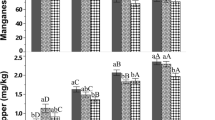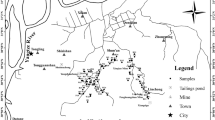Abstract
STRONTIUM-90 is one of the long-lived radionuclide constituents of fall-out that can be expected as a contaminant of cereal grains for long periods of time. Much of the strontium-90 content of wheat grain is believed to result from direct floral interception rather than to uptake from previously contaminated soils1,2. It has also been reported that over extended time periods soils experiencing greater annual precipitation accumulated more strontium-90 than did soils of drier regions3. From these premises it would seem that wheat growing in regions experiencing marked spring precipitation should exhibit higher strontium-90 contents than wheat grown in regions with relatively weak spring precipitation. An inspection of precipitational data and a knowledge of the spring floral development of wheat suggest that wheat grown in eastern Montana might yeild a higher strontium-90 content that Idaho grown wheat (Fig. 1).
This is a preview of subscription content, access via your institution
Access options
Subscribe to this journal
Receive 51 print issues and online access
$199.00 per year
only $3.90 per issue
Buy this article
- Purchase on Springer Link
- Instant access to full article PDF
Prices may be subject to local taxes which are calculated during checkout
Similar content being viewed by others
References
Rivera, J., Science, 133, 755 (1959).
Committee on Effects of Atomic Radiation on Agriculture and Food Supplies, Nat. Acad. Sci.—Nat. Res. Council. Washington, D.C., Pub. 1092 (1963).
Hardy, E., and Alexander, L. T., Science, 136, 881 (1962).
Millar, C. E., and Turk, L. M., Fundamentals of Soil Science (Wiley and Sons, Inc., New York, 1941).
Health and Safety Laboratory—HASL-140 Fall-out Progr. Quart. Summary Rep. (U.S.A.E.C. New York Operations Office, 1963).
Olson, jun., T. A., Science, 135, 1064 (1962).
Climate and Man: U.S.D.A. Yearbook, 1248 (U.S. Gov. Printing Office, Washington. D.C., 1941).
Climatological Data Annual Summary for Idaho and Montana (U.S. Dept. Commerce Weather Bureau, Asheville, N.C., 1959).
Author information
Authors and Affiliations
Rights and permissions
About this article
Cite this article
RICKARD, W. Spring Precipitation and the Strontium-90 Contamination of Wheat in the Semi-arid Regions of Idaho and Montana. Nature 201, 309–310 (1964). https://doi.org/10.1038/201309b0
Issue Date:
DOI: https://doi.org/10.1038/201309b0
Comments
By submitting a comment you agree to abide by our Terms and Community Guidelines. If you find something abusive or that does not comply with our terms or guidelines please flag it as inappropriate.



